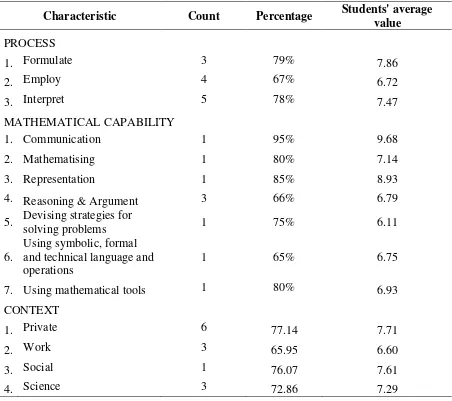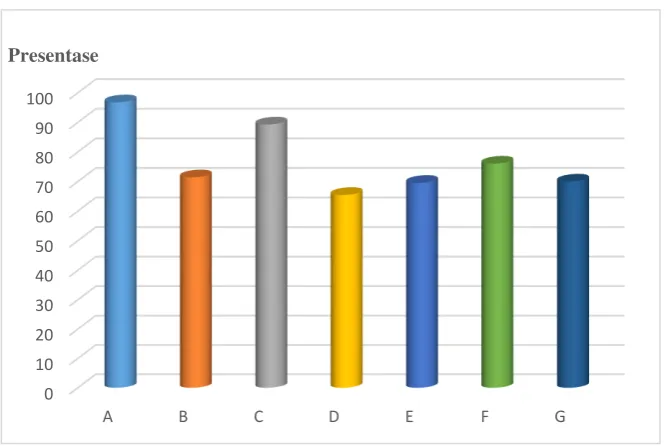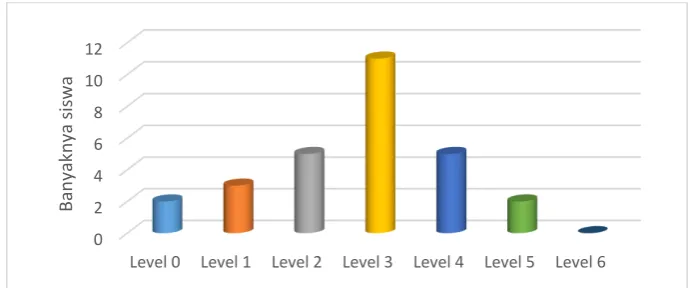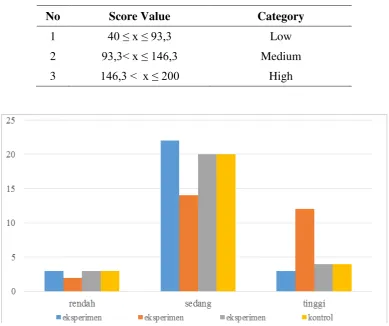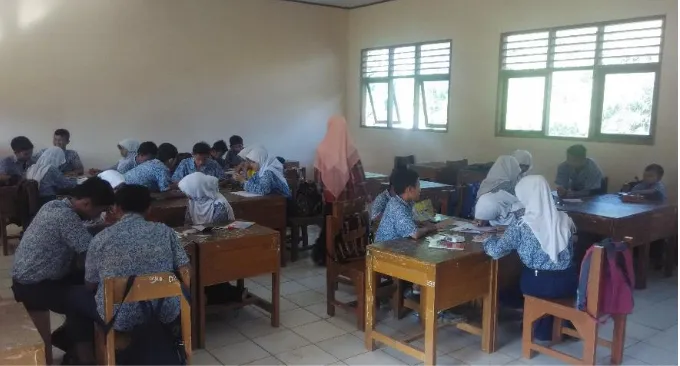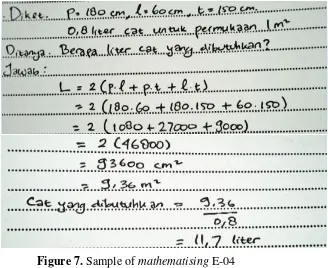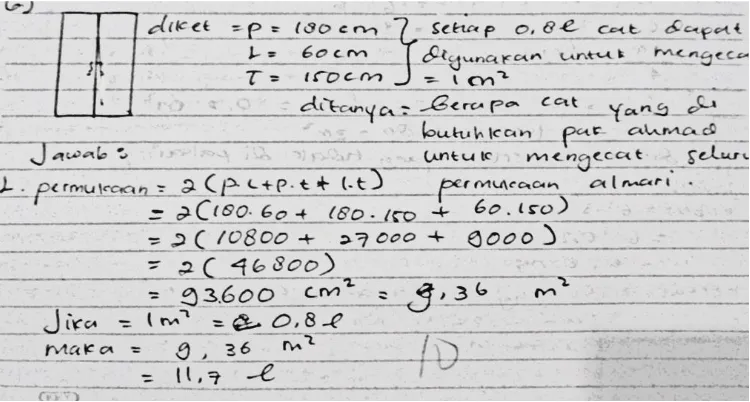DOI 10.22460/infinity.v6i1.236
77
THE ANALYSIS OF DIAGNOSTIC ASSESSMENT RESULT IN
PISA MATHEMATICAL LITERACY BASED ON STUDENTS
SELF-EFFICACY IN RME LEARNING
Khaerunisak1, Kartono2, Isti Hidayah3. Ahmad Yusril Fahmi4
1Universitas Selamat Sri, Kendal East Java, Indonesia
2,3 Mathematics Education Semarang State University, Semarang East Java, Indonesia 4
Teacher MTs Walisongo, Pekalongan East Java, Indonesia
1[email protected], 2[email protected], 3[email protected], 4[email protected]
Received: January 2, 2017 ; Accepted: January 29, 2017 Abstract
This research aimed to test RME learning with an effective scientific approach to improving mathematical literacy and self-efficacy, obtaining an overview of the mathematical literacy diagnostic assessment results that has high, medium and low self-efficacy as well as student difficulties in learning RME with a scientific approach. This research using mix method concurrent embedded with the subject of research is students class VIII. The research begins with a mathematical literacy diagnostic assessment and self-efficacy inventory then performed RME learning in experimental class and conventional learning in control class. Quantitative analysis was conducted to test the effectiveness of learning and deepened with the interview as a qualitative analysis. Learning RME with a scientific approach effective is marked by the achievement of classical completeness, the proportion of students' mathematical literacy, self-efficacy and the difference in pre-post students’ mathematical literacy on RME learning better than conventional learning. The results of students’ mathematical literacy diagnostic assessment fit the criteria of self-efficacy students except for medium mathematical literacy that having high self-efficacy. Student difficulties in RME learning with the scientific approach are based on the results of mathematical literacy diagnostic assessment, namely language skills problem, the capacity to understand, create strategies, and create the algorithm.
Keywords:Mathematics Literacy, Self-efficacy, RME, Diagnostic Abstrak
Penelitian ini bertujuan untuk menguji pembelajaran RME dengan pendekatan saintifik efektif meningkatkan literasi matematika dan self-efficacy, memperoleh gambaran hasil penilaian diagnostik literasi matematika yang memiliki self-efficacy tinggi, sedang dan rendah serta kesulitan siswa dalam pembelajaran RME dengan pendekatan saintifik. Metode penelitian ini menggunakan mix method cuncurrent embbeded dengan subyek penelitian siswa kelas VIII. Penelitian diawali dengan penilaian diagnostik literasi matematika dan inventori self-efficacy selanjutnya dilakukan pembelajaran RME pada kelas eksperimen dan pembelajaran konvensional pada kelas kontrol. Analisis kuantitatif dilakukan untuk menguji keefektifan pembelajaran. dan diperdalam dengan wawancara sebagai analisis kualitatifnya. Pembelajaran RME dengan pendekatan saintifik efektif ditandai dengan tercapainya ketuntasan klasikal, proporsi literasi matematika siswa, self-efficacy siswa dan selisih literasi matematika awal-akhir pada pembelajaran RME lebih baik daripada pembelajaran konvensional. Hasil penilaian diagnostik literasi matematika siswa sesuai kriteria self-efficacy siswa kecuali untuk literasi matematika sedang yang memiliki self-efficacy tinggi. kesulitan siswa dalam pembelajaran RME dengan pendekatan saintifik berdasarkan hasil penilaian diagnostik literasi matematika, yakni kesulitan kemampuan bahasa, kemampuan memahami, membuat strategi, dan membuat algoritma.
How to Cite: Khaerunisak, Kartono, Hidayah, I. & Fahmi, A. Y. (2017). The Analysis of
Diagnostic Assesment Result in Pisa Mathematical Literacy Based on Students Self-Efficacy in RME Learning. Infinity, 6 (1), 77-94.
INTRODUCTION
Education has an important role in educating the human resources to be able to compete globally in the development of science and technology. This is in accordance with national education goals outlined in ACT Number 20 Year 2003 on National Education System. Through education, students are equipped with knowledge and skills needed in school and its application in real life. Students have certain aspects that can be measured and the results can provide useful information for improving the quality of education through the study. For example, the study Programme for International Student Assessment (PISA), the international literacy study is a form of skills and knowledge evaluation that are designed for students aged 15 years, were carried out every 3 years under the auspices of the Organization for Economic Co-operation and Development (OECD). PISA aims to assess the 15-year-old students in OECD countries and other countries in the achievement of reading proficiency, mathematics literacy, and science to make a contribution towards its member of his country (Wilkens, 2011).
The results of PISA study in 2003, Indonesia was ranked 39 out of 40 countries and the following year was also not encouraging. PISA results in 2009 showed that the mathematics literacy score for Indonesia students ranked 61 out of 65 participating countries and the results of the latest PISA in 2012, Indonesia was ranked 64 out of 65 survey participants countries. Although the results of PISA 2015 have elevated points with Indonesia was ranked 64 out of 72 countries. This indicates a mathematical literacy SMP/MTs students in Indonesia is still low.
According to Dzulfikar, Asikin & Hendikawati (2012), mathematical subjects for many students still considered as a difficult lesson, scary, and less useful in everyday life, such as for many students a math lesson seemed difficult and unattractive. This case makes many students became less motivated to learn math and have an impact on student difficulties in solving mathematical problems caused by the inability of students to understand or remember the basic concepts of mathematics ever learned before. Particularly with the condition of students in Indonesia are not familiar with modeling form question, which requires the ability to translate everyday problems in the form of formal mathematics to
completing it. Thus, students’ mathematical literacy skills need to be cultivated so that the
result of student learning outcomes increased in mathematics learning.
Student difficulties in interpreting the real problem into a mathematical model needed to be diagnosed the source of the problem and held a follow-up to resolve the issue. One of them by having a diagnostic assessment. The diagnostic assessment in the form of diagnostic tests are given to know the strengths and weaknesses in learning (Hughes in Suwarto, 2013) so that learning can be improved and the learning objectives are achieved. Sion & Jingan (Suwarto, 2013) States the diagnostic test as a test that provides information to teachers on students' prior knowledge and misconceptions before starting the activity. With the diagnostic assessment can know things that need to be repaired and improved and things that need to be maintained in the implementation of learning. Assessment obliges teachers to gather information as complete as possible for the purpose of decision making of teaching so that teaching decisions can be precisely targeted, one of them is diagnostic assessment (Hidayat, Sugiarto & Pramesti, 2013). According to Shute, Graf & Hansen (2006) There are three aspects in the diagnostic evaluation that includes diagnostic process of determining the nature of a child's ability in a learning activity, the diagnostic process should be able to classify the students' cognitive abilities, diagnostics is part of a larger learning process with the main aim to identify problems and help overcome learning problems.
Based on the results of diagnostic assessments, needs to be followed in determining the strategies and appropriate learning methods about mathematical literacy. Judging from the characteristics of mathematical literacy that is often associated with contextual issues appropriate if applied with a Realistic Mathematic Education (RME) learning. In addition to the application of RME, need to hold scaffolding for some students who do not meet the KKM. In this process, the teacher explains the material that has not been mastered by students without looking at the concepts, principles, and procedures that are not yet fully understood by students.
The application of the scientific approach that adopted scientists measures to build knowledge through scientific methods, 2013 Curriculum can help students' skills in reasoning subject matter based on the evidence of the observable, empirical and measurable object. 2013 Curriculum were applied in SMP N 2 Wonopringgo because included in the pilot schools (pilot project) from Kemendikbud Pekalongan. RME learning can be applied at SMP 2 Wonopringgo due to suitable with curriculum 2013 regarding RME characteristics that in line with the character of a scientific approach (implementation of 2013 curriculum).
The pessimistic tendency of students in learning mathematics because students' views of mathematics that are still considered difficult and scary subjects make the daunting obstacles when students solve a math problem. Students who thus have a timid soul, less bold in making decisions, and less daring responsible for the actions that have been carried out. Therefore, it takes a strong self-efficacy on students so that they can succeed in learning mathematics. Self-efficacy beliefs influence the choice of duty, endurance and persistence efforts and achievement.
achievement directly by increasing the value of students interest. Pintrich and De Groot (1990) found that students who believe that they can perform academic tasks using cognitive and metacognitive strategies more and keep doing better than students who do not believe. Self-efficacy is making a difference in the way people act, as a follow-up of feelings and thoughts. People who believe that they can do something that has the potential to transform environmental events are more likely to act and more likely to succeed than those with low self-efficacy. Behavior is influenced by the extent to which one believes can perform the actions required by certain situation.
Learning certainly requires the right strategy for learning optimally implemented. Although learning has been applied, the need for improvement of learning to optimize student learning outcomes, the next step to improve learning by taking into account the results of a diagnostic assessment of Realistic Mathematic Education (RME) learning approaches. RME developed by Hans Freudenthal have two views, i.e. mathematics must be connected to reality and mathematics as human activity (Gravemeijer in Tandililing, 2010). Based on that idea, mathematics should be close to the students and should be relevant to everyday life situations. The situation that is relevant to everyday life will help the learning process that is meaningful to students so that students were able to find their own concepts and ideas of mathematics, must be mapped. In addition, he also emphasizes that mathematics as a human activity, so students should be given the opportunity to learn to perform activities of all the topics in mathematics. As a consequence, teachers must be able to develop interactive teaching and give students opportunities to contribute to their learning process.
In connection with the background that has been described, presented some of the research questions as follows: (1) Is the RME learning with scientific approach effective against to mathematical literacy and self-efficacy? (2) How do the results of the students' mathematical literacy diagnostic assessment in RME learning with scientific approach that has high, medium and low self-efficacy students? (3) How do the results of the students' mathematical literacy diagnostic assessment in conventional learning with a scientific approach that has high, medium and low self-efficacy students? (4) How is the student's difficulties on RME learning with a scientific approach based on the results of the mathematical literacy diagnostic assessment?
METHOD
This study is a combination of qualitative and quantitative research. Combinations model used in this study is the type of concurrent embedded strategy. In this study, quantitative research as the primary method while quantitative research as a secondary method. The population in this study were students of SMP Negeri 2 Wonopringgo the second semester of the academic year 2014/2015. From classes VIII in SMP Negeri 2 Wonopringgo 3 classes randomly selected as samples in accordance with the study design, the first experimental class, which in the classroom experiment applying the RME learning model. Secondly, the control class where the learning applying the learning model used by their teacher and the third is a trial class is a class that is used for the analysis of test trials.
can not be granted scaffolding because of his ability is too low so that students continue to experience difficulties if given assistance.
There were 17 students who get the scaffolding from the results of the mathematical literacy diagnostic assessment at the end of each learning of meeting I, whereas in the meeting II and III there are 5 students who get the scaffolding. Mathematical literacy diagnostic assessment 1 results got an average value of 5 and a standard deviation of 2, so the ZPD area is located in 3<ZPD<7. Mathematical literacy diagnostic assessment 2 results get the average value of 3.58 and standard deviation of 6.35, so the ZPD is located on 3<ZPD<10. Mathematical literacy diagnostic assessment 3 results got average value of 6.46 and standard deviation of 3.37, so the ZPD is located on 3.1<ZPD<9.8. The results of the mathematical literacy diagnostic assessment 4 scored an average rating of 7 and a standard deviation of 2. Implementation of mathematical literacy diagnostic assessment 4 as habituation, so that the results of mathematical literacy diagnostic assessment 4 is not analyzed because the next meeting is already entering a final mathematical literacy diagnostic assessment. Mathematical literacy diagnostic assessment final results get an average score of 73 and a standard deviation of 13, so the ZPD is located at 6<ZPD<86.
Data collection techniques in this research consisted of observation, testing, and interviews. Data analysis was performed at a stage before the field up to the analysis stage during in the field. Analysis before on the field is done by device and research instruments validation. Analysis during in the field was compiled in a systematic quantitative and qualitative data that obtained from observation results, diagnostic tests, and interviews. Quantitative data analysis that obtained from diagnostic tests data to determine the effectiveness of RME learning with scientific approach consists of completeness test with z-test, class completeness proportion test, different mean SE samples class and different test of deviation mean pre-post ability of class sample. While the qualitative data analysis done by reducing the data, presenting the data, and draw conclusions from data that has been collected and verified these conclusions. Recapitulation of data validation results are presented in Table 1.
Table 1. Recapitulation Data Validation Results
RESULTS AND DISCUSSION
Results
Characteristics of mathematical literacy diagnostic question can be viewed from three aspects, namely the component processes, mathematical skills, and component context. Table 2 is a table of data about the characteristics of diagnostic mathematical literacy.
Table 2. Characteristic data of Diagnostics Mathematical Literacy question
Characteristic Count Percentage Students' average
value
PROCESS
1. Formulate 3 79% 7.86
2. Employ 4 67% 6.72
3. Interpret 5 78% 7.47
MATHEMATICAL CAPABILITY
1. Communication 1 95% 9.68
2. Mathematising 1 80% 7.14
3. Representation 1 85% 8.93
4. Reasoning & Argument 3 66% 6.79
5. Devising strategies for
solving problems 1 75% 6.11
6.
Using symbolic, formal and technical language and operations
1 65% 6.75
7. Using mathematical tools 1 80% 6.93
CONTEXT
1. Private 6 77.14 7.71
2. Work 3 65.95 6.60
3. Social 1 76.07 7.61
4. Science 3 72.86 7.29
Figure 1. The average percentage of Mathematical Literacy contain Mathematical Capability
E = Devising Strategies for Solving Problems
F = Using Symbolic, Formal and Technical Language and Operation
G = Using Mathematics Tools
According to the component context, the focus of PISA is meant as a situation which is reflected in a problem can be seen in Figure 2 below.
Figure 2. The average percentage of Mathematical Literacy contain Component Context
The question of mathematical literacy diagnostic test used in the study analyzes the learning process and students' mathematical literacy skills on geometry material class VIII SMP
Negeri 2 Wonopringgo with sub-subject material cubes and blocks considering three large components identified in PISA, i.e. based on the components of the content or material learned in school. In this study, the researchers consider parts of space and form only because this section relates to the geometry subject. The questions of mathematical literacy ability test include three components which were tested in the PISA study as well as paying attention to the seven important things that support the occurrence of the process ability and also such questions created by observing the fourth component context the focus in PISA. The following will be outlined identifications numbers mathematical literacy diagnostic test item.
Question number 1 included in the category space and shape content components, process component parts of interpret, and included in a social context as well as the types of questions that could measure the highest value Communication ability that achieved by eighth grade students when working on Question 1 is 10 corresponding to maximum value of questions number 1, there were 25 eighth grade students who get the maximum value, but there is one student who received a minimum grade of 5. Average correct answer reached 9.7 or equivalent to 97% of the average of correct answers obtained by the students in the class.
Question number 2 is a space and shape content components, process component that parts of formulate also include the types of questions that can measure the representation ability, and are included in the personal context. The highest value of Question 2 is 10 which is the maximum value, while the minimum value is 3. The average of correct answers reached 8.9, equivalent to 89% of the average correct answer obtained by the students.
Question number 3 is a space and shape content components, process component that parts of intepret also include the types of questions that can measure the ability of Using symbols, formal and technical language and operations. Question number 3 is included in a social context. Question number 3 highest score is 10 and also the maximum score while the minimum value is 2. The average of correct answers reached 7.6, equivalent to 76% of the average correct answers obtained by the students.
Question number 4 is a space and shape content component, process component that parts of formulate and types of question that can measure the ability of Communication and include in a personal context. The highest value of Question 4 is 10, and the maximum score number 4 is 10, while the minimum value is 1. The average correct answer of 7.1, equivalent to 71% of the average correct answer obtained by the students.
Question number 5 is a space and shape content component, process component that parts of employ and types of questions that can measure the ability of Reasoning and Argument also included in a personal context. Question number 5 the highest score is 10 and the minimum value of Question 5 that is 1. Average of correct answers was 6.8, or an average of correct answers obtained by the students is 68%.
Question number 7 is a space and shape content component, process component that parts of employ, and include mathematical literacy question that can involve the ability of devising strategies for solving problems, and included in the work context. The highest value a question number 7 is 10, while the minimum value is 1. The average of correct answers reaching 6.9, equivalent to 69% of the average correct answers obtained by the students.
Question number 8 is a space and shape content component, process component that parts of employ and include the types of mathematical literacy question that can involve the ability in devising strategies for solving problems, and is included in the personal context. The highest value question number 8 is 10, while the minimum value is 1. The average of correct answers up to 6.2, equivalent to 62% of the average correct answers obtained by the students.
Question number 9 is a space and shape content component, process component that parts of formulate and include the types of mathematical literacy question that can involve the ability of reasoning and arguments, and including in the science context. The highest value question number 9 is 10, while the minimum value is 3. The average of correct answers reaches 7.5, equivalent to 75% of the average correct answers obtained by the students.
Question number 10 is a space and shape content component, process component that parts of interpret and include the types of mathematical literacy question that can involve the ability of reasoning and arguments, and included in the work context. The highest value question number 10 is 10, while the minimum value is 0. The average of correct answers was 6.1, equivalent to 61% of the average correct answers obtained by the students.
Question number 11 is a space and shape content component, process component that parts of interpret and include the types of mathematical literacy question that can involves the ability of devising strategies for solving problems, and included in the work context. The highest value about the number 11 is 10, while the minimum value is 0. The average of correct answers was 6.8, equivalent to 68% of the average correct answers obtained by the students.
Problem number 12 is a space and shape content component, process component that parts of interpret and include the types of mathematical literacy question that can involve the ability of devising strategies for solving problems, and including in the science context. The highest value question number 12 is 10, while the minimum value is 2. The average of correct answers, equivalent to 7.2% of the average correct answers obtained by the students. Percentage of each level in PISA is shown in Figure 3 below.
Figure 3. Mathematical Literacy Level Students based on PISA
0
Level 0 Level 1 Level 2 Level 3 Level 4 Level 5 Level 6
To get a more in-depth overview of related research results, students' mathematical literacy were grouped into three categories: low, medium, high. Frankel and Wallen (2009) stated that almost all score in the normal distribution is on average range minus 3 times the standard deviation and the average plus three times the standard deviation.
From the results of mathematical literacy diagnostic tests done there are 2 students had a high category of mathematical literacy, 21 students had a moderate category, and 5 students had a low category of mathematical literacy. This results in mathematics literacy score is presented in Table 3 below.
Table 3. Category of Mathematical Literacy
No Students Code Category
1 E-10, E-13 high
2 01, 02, 03, 04, 05, 06, 07, 08, 09, 11, 12, 14, 15,
E-16, E-19, E-22, E-23, E-24, E-25,E-27, E-28
medium
3 E-17, E-18, E-20, E-21, E-26 low
Self-efficacy is also categorized into high, medium, and low self-efficacy with the provisions of the students with the average score as follows.
Table 4. Categorized Score Students’ Self-Efficacy
No Score Value Category
1 40 ≤ x ≤ 93,3 Low
2 93,3< x ≤ 146,3 Medium
3 146,3 < x ≤ 200 High
Based on Figure 4 Grouping of self-efficacy at the preliminary and final assessment results it appears that the students' efficacy assessment results have increased. Increased self-efficacy assessment results found in the experimental class that implements RME learning model. Furthermore, the final self-efficacy assessment results will be examined more deeply about mathematical literacy through interviews and the results of final mathematical literacy diagnostic test, then the subjects will be selected as follows.
a. 3 subjects in the low self-efficacy category that meet the first, second and third quartiles
as the subjects of the experimentation, i.e. E-17 and E-21 because there are only 2 subject categories low self-efficacy and subject K-14. K-16 and K-22 as control subjects.
b. 3 subjects in the middle self-efficacy category wthat meet the first, second and third quartile as subjects of the experimentation, i.e. E-5, E-04 and E-20 and the subject K-23, K-13, K-9 as control subjects.
c. 3 subjects in the high self-efficacy category that meet the first, second and third quartile as subjects of the experimentation, i.e. E-25, E-08 and E-13 and the subject K-27, K-24, K-8 as control subjects.
Based on interviews with students, resulting in that students who have high levels of self-efficacy if they supported by a responsive environment, then there is a behavior change in the form of student successfully carry out tasks according to its ability or good results in mathematical literacy diagnostic test. However, students who have high levels of self-efficacy if it is not backed by a responsive environment, then these students strive to change the environment to becomes responsive or even forcing a change to get a great result in the next literacy test through diligently inquired and diligently practicing and carry out tasks assigned by the teacher. While students who have low levels of self-efficacy if supported by environmentally responsive, these students become resigned and was not able to work on math literacy question and not even have spirit and reluctant to do the work assigned by the teacher and refused to write the results of discussions/duties despite encouragement, motivation and the spirit that has been given by the teacher. Also with the students who have low levels of self-efficacy if it is not backed by a responsive environment, the students have low self-esteem to see their friend can work on the literacy question that considered difficult. For students who have high levels of self-efficacy were either supported or not supported by the responsive environment, the behavior of the students is more likely to be higher or lower depending on the condition of the individual. This is consistent with the theory of Bandura (Feist & Feist, 2006) that the high-low self-efficacy correlated with the environment that is responsive and unresponsive, as follows: (a) If the high self-efficacy and environmentally responsive, the most results can be expected is a success, (b) when the self-efficacy is low and environmentally responsive, people can become depressed when they observe others successfully accomplish tasks which according to them is difficult, (c) when the high self-efficacy meet with the unresponsive environmental situation, humans usually will strive to change the environment, for example in protest, social activism, (d) When low self-efficacy in combination with an environment that is not responsive, humans will conduct apathy, give up easily, feeling powerless.
Discussion
1. Quantitative Analysis
The calculation results of learning completeness the experimental class using right parties
proportion test obtained z-value = 1.75. At α = 5% was obtained z_ (0.5-α) = z0,45 = 1.64.
value for z_value = 5.36. At α = 5% was obtained z_critical = 1.64. Because z_value> z_critical, then the proportion of mathematics literacy diagnostic test results experimental class students is better than the proportion of mathematics literacy diagnostic test of control class. Based on the calculation, the t¬value = 2.025 and t-critical = 1.67. Because 2.025>1.67 so t-value> t-critical. This information shows that self-efficacy of experiment class students better than the control class. t-value = 1.913 and t-critical = 1.67. Because t-critical > t-critical then the difference between preliminary and final mathematical literacy value of experimental class students better than difference between preliminary and final mathematical literacy value of control class.
RME learning model with scientific approach effective against students' mathematical literacy. This is because (1) the percentage of students in RME learning has reached completeness, i.e. more than 75%; (2) the proportion of diagnostic mathematical literacy tests results of experimental class is better than the diagnostic mathematical literacy tests results of control class; (3) Students' self-efficacy of experimental class is better than self-efficacy of control class; and (4) the average difference between preliminary and final students' mathematical literacy of experiment class better than the control class.
Figure 5. Photo of Application of Using Realistic Mathematics Education
2. Qualitative Analysis
Mathematical Literacy diagnostic test results and interviews were used to analyze mathematical literacy students based on self-efficacy is divided into 7 indicators, namely communication, mathematising, representation, reasoning and argument, devising strategies for solving problems, using formal and symbolic, technical language and operation, and using mathematics tools. Here is a snippet of the students' answers on RME learning indicating that the student E-17 has the poor mathematising ability and low self-efficacy.
Figure 6. Sample of Matematising E-17
From Figure 6 it is shown that students E-17 less able to change the real world problems into mathematical form or just the opposite, namely students E-17 are less able to interpret a result or mathematical models into the original problem. Figure 10 is a snippet of the students' answers on RME learning indicating that the student E-04 has the good mathematising ability and medium self-efficacy. From Figure 10 shows that the students E-04 capable of changing the real world problems into mathematical form or just the opposite, namely student E-04 is able to interpret the results or mathematical model to the original problem.
Figure 7 is a snippet of students' answers on RME learning indicating that the student E-13 has the good mathematising ability and high self-efficacy. From the figure is seen that students E-13 capable of changing the real world problems into mathematical form or just the opposite, namely student E-13 is able to interpret the results or mathematical model into the original problem.
Figure 8. Sample of mathematising E-13
In RME learning, group of students who have low self-efficacy largely can not reach seven indicators of mathematical literacy and contains low mathematical literacy category anyway. For most of the students who have medium self-efficacy was reached seven indicators of mathematical literacy, it's just only in his achievements on each indicator is insufficient e.g. in the achievement indicators number 6, students who have medium self-efficacy has reached indicator number six but could not understand between relationship of problem context with problem representation. medium self-efficacy was having medium mathematical literacy category and can only achieve level 3, while most of the students who have high self-efficacy has reached maximum seven mathematical literacy indicators. High self-efficacy has medium and high mathematical literacy and has reached level 5.
In the study by Collins (Mukhid, 2009) about self-efficacy revealed that children that mathematical capable, has stronger self-efficacy beliefs. The same was stated by Somakim (2011) says that there is significance in increasing students' mathematical self-efficacy ability between learning using realistic mathematics approach and usual mathematical approach. Additionally, Dzulfikar (2013) shows that the importance of mathematically self-efficacy to be owned by each student is also mandated in the purpose of mathematics courses given to students is that they have respect for the usefulness of mathematics in life, i.e. have curiosity, attentive, and interest in learning mathematics, as well as a tenacious attitude and confidence in problem solving. Peters (2013), show that students who have high self-efficacy also have high mathematics achievement.
study support previous research conducted by Alfieri, Brooks, Aldrich & Tenenbaum (2011) in his research, he mentions that the DL model has the potential formation of misconception, because when students were left to find the information or facts and new knowledge itself, it is feared the lesson will undergo a series of mistakes, misconceptions, making them frustrated and confused about what is being studied. Discovey Learning also has the potential formation of cognitive overload (make it difficult for students who need more structured learning). It is accordingly presented by Kirschner, Sweller & Clark (2006) says "Cognitive load theory suggests that the free exploration of a highly complex environment may generate a heavy working memory load that is detrimental to learning".
In the control class, group of students who have low self-efficacy largely can not reach all mathematical literacy indicators. Most of the students in this category still find it difficult to accept and act upon the given question. Low self-efficacy had lower math literacy category anyway and can only reach level 1 but some are not reaching the level of mathematical literacy. For medium self-efficacy, most of the students have achieved four of the seven mathematical literacy indicator are met with good although even in the achievement of the indicators of mathematical literacy is still less than the maximum. The results of his work looks less clear and not easy to understand. Medium elf-efficacy had medium mathematical literacy category and can reach level 3 but some are not reached the mathematical literacy level. For high self-efficacy, some defecate students who have high self-efficacy has achieved some mathematical literacy indicators properly. In this category students can provide answers and acceptable solution although less than perfect. High self-efficacy has medium or and low mathematical literacy category can only reach level 2.
Diagnostic tests in this research also used to analyse the students difficulties. Four student difficulties in RME learning with scientific approach based on the results of the diagnostic assessment of mathematical literacy in each category of self-efficacy. First, the difficulty the ability to translate problems into mathematical language occurred in the group of students who have low self-efficacy. The reason is that students are less careful in reading the questions and students are less careful in expressing information that exists on the question, not uncommon among them did not write down any information that known from question given by teachers. Second, the ability to understand the difficulties occurred in the group of students who have low self-efficacy. Most of them are less able to write formulas or concepts used in determining the answer to the given question. The reason is that students do not understand the explanation given. Third, the difficulty in the ability to make the strategy happen on a group of students who have low and medium self-efficacy. The reason is that students do not understand the concepts and principles that have been studied and students are less thorough in completing the answer. Fourth, difficulties in the ability to perform troubleshooting steps occurred in the group of students who have low and medium self-efficacy. The reason is that students are less scrupulous and often students do not write a conclusion on the results of the answer, he just wrote the final results of the calculation operation.
(algoritmic knowledge). The reason is that students are less scrupulous and often students do not write a conclusion on the results of the answer, he just wrote the final result of the calculation operation.
CONCLUSION
RME Learning with scientific approach proven effective to mathematical literacy and self-efficacy. The results of the mathematical literacy diagnostic assessment fit the criteria of students' self-efficacy except for middle mathematical literacy that having high self-efficacy.
Students' self-efficacy need to be inculcated through the creation of environmental conditions that are responsive and personal approach to students. Mathematical literacy is one of the most important skills in learning mathematics. Students' Mathematical literacy are not directly grown well and needed proper exercise to train this ability to develop properly. One way to practice math literacy and create a responsive environment is to adopt RME learning with scientific approach. Teachers need to do an analysis of student difficulties in resolving the question to improve the next learning and materials in finding solutions for student difficulties.
ACKNOWLEDGMENTS
The author would like to thank SMP 2 Wonopringgo which had allowed the execution of this research at the school.
REFERENCES
Alfieri, L., Brooks, P. J., Aldrich, N. J., & Tenenbaum, H. R. (2011). Does Discovery-Based
Instruction Enhance Learning? Journal of Educational Psychology, 1-18.
Dewanto, S. (2008). Peranan Kemampuan akademik Awal, Self-efficacy, dan Variabel Non Kognitif Lain terhadap Pencapaian Kemampuan Representasi Matematis Mahasiswa
melalui Pembelajaran Berbasis Masalah. Educationist, 8(2), 123-133.
Dzulfikar, A. (2013). Studi Literatur: Pembelajaran Kooperatif dalam Mengatasi Kecemasan
Matematika dan Mengembangkan Self Efficacy Matematis Siswa. Seminar dan
Musyawarah Nasional MIPA (pp. 45-54). Yogyakarta: UNY.
Dzulfikar, A., Asikin, M., & Hendikawati, P. (2012). Keefektifan Problem Based Learning
dan Model Eliciting Activities terhadap Kemampuan Pemecahan Masalah. Unnes
Journal of Mathematics Education, 1(1), 1-6.
Feist, J., & Feist, G. J. (2006). Theories of Personality. Ed. VI. Yogyakarta: Pustaka Pelajar.
Haji, S., & Abdullah, M. I. (2015). Membangun Kemandirian Belajar Siswa Melalui Pebelajaran Matematika Realistik. Infinity, 4(1), 39-46.
Hidayat, B. R., Sugiarto, B., & Pramesti, G. (2013). Analisis Kesalahan Siswa dalam Menyelesaikan Soal pada Materi Ruang Dimensi Tiga Ditinjau dari Gaya Kognitif Siswa (Penelitian dilakukan di SMA Negeri 7 Surakarta Kelas X Tahun Ajaran
Kirschner, P. A., Sweller, J., & Clark, R. E. (2006). Why Minimal Guidance During Instruction Does Not Work: an Analysis of the Failure of Constructivist, Discovery,
Problem-Based, Experiential, and Inquiry-Based Teaching. Educational Psychologist,
41(2), 75-86.
Krismiati, A. (2013). Penerapan Pembalajaran dengan Pendidikan PMR secara Berkelompok untuk Meningkatkan Kemampuan Pemecahan Masalah Matematis Siswa di Kelas X SMA. Infinity, 2(2), 123-135.
Mukhid, A. (2009). SELF-EFFICACY (Perspektif Teori Kognitif Sosial dan Implikasinya terhadap Pendidikan). Jurnal Pendidikan Islam, 4(1), 1-17.
Nicolaidou, M., & Philippou, G. (2003). Attitudes Towards Mathematics, Self-Efficacy and
Achievement in Problem Solving. European Research in Mathematics Education III.
Pisa: University of Pisa. 1-11
Peters, M. (2013). Examining the relationshops among classroom climate, self-efficacy, and
achievement in undergraduate mathematics: a multi-level analysis. International
Journal Science and Mathematics Education, 11(2); 459-480.
Pintrich, P.R. and De Groot, E.V. (1990). Motivational and Self-Regulated Learning
Components of Classroom Academic Performance”. Journal of Educational
Psychology, 82(1); 33-40.
Satoto, S., Sutarto, H., & Pujiastuti, E. (2012). Analisis Kesalahan Hasil Belajar Siswa dalam
Menyelesaikan Soal dengan Prosedur Newman. Unnes Journal of Mathematics
Education, 1(2).
Shute, V. J., Graf, E. A. and Hansen, E. G. (2006), Designing Adaptive, Diagnostic Math Assessments for Individuals With and Without Visual Disabilities. ETS Research
Report Series, 2006: i–37. doi:10.1002/j.2333-8504.2006.tb02007.x
Somakim. (2011). Membangun Kepercayaan Diri (Self-Efficacy) Siswa Melalui Pendidikan
Matematika Realistik Indonesia. Pidato Ilmiah: UNSRI.
Stacey, K. (2011). The PISA View of Mathematical Literacy in Indonesia. Journal on
Mathematics Education (IndoMS-JME), 2(2) ;95-126.
Suwarto. (2013). Pengembangan Tes Diagnostik Dalam Pembelajaran. Yogyakarta: Pustaka
Pelajar.
Tandililing, E. (2010). Implementasi Realistic Mathematics Education (RME) di Sekolah.
Jurnal Guru Membangun, 25(3).
Tarigan, D. (2006). Pembelajaran Matematika Realistik. Jakarta: Departemen Pendidikan dan
Kebudayaan Direktorat Jendral Pendidkan Tinggi.
Wardono dan Mariani, S. (2014). The Realistic Learning Model With Character Education
And PISA Assessment To Improve Mathematics Literacy. International Journal of
Education and Research, 2(7), 361-372.
Wigfield, A & Eccles, J. (2001). Development of Achievement Motivation. San Diego: Academic Press.
Wilkens, Hendrianne, J. (2011). Textbook approval systems and the Program for International
Zimmerman, B. J., Bandura, A., & Martinez-Pons, M. (1992). Self-motivation for academic attainment: The role of self-efficacy beliefs and personal goal setting. American

